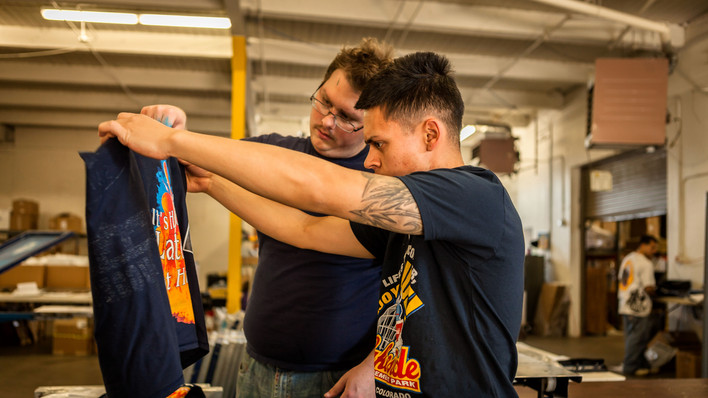In-store experiences have always been a strong driver of revenue for brands. Research from a First Insight report found that 71% of shoppers spent $50 or more when shopping in-store than online. Moreover, both men and women were at least 10% more likely to sometimes or always add additional items to their cart when shopping in-person versus online.
With the pandemic pushing more consumers online, many brands have seen their in-store traffic decrease significantly. In research published in eMarketer, 40% of consumers said they relied exclusively on online shopping in 2020, and 43% of shoppers anticipate continuing to shop online versus returning to their in-store habits.
As vaccines become increasingly available and more consumers feel comfortable shopping in-person again, marketers will need to make a solid push to shift consumers back to in-person shopping. And that’s where printed signage and advertising can help.
Change customer behavior — again
Switching to online shopping was a significant change for consumers, but many have grown accustomed to the convenience of shopping online over the past year, which is why so many say they will stick with it. Brands have also begun investing in making the online experience more like the in-store experience through 360-degree product videos, online chats with store associates, and the ability to try on and return items easily. But, the in-store experience still offers something online never can — the ability to touch and feel products before buying.
“The reality is that customers want to see and test things. It’s why big box retailers still exist,” says Franco Alegria, National Account Manager at FedEx Office. “We know part of the loyalty customers have to our brand comes from being able to provide consultations and giving guidance on the solution to their challenges. Customers still want and need these types of high-touch, in-person experiences.”
Marketers need to remind customers why they want and need in-person brand experiences — and a great way to do this is through printed advertising. Whether it’s direct mail that reminds them they can come in and touch and feel your products themselves or signage that will catch their eye as they’re walking or driving past — print advertising stands out. Direct mail, in particular, allows you to make a greater impression through activating the different senses — something digital advertising can’t do to the same extent. Scented mailers are especially popular for perfume and cosmetic companies, but can also be used for restaurants, bakeries and even garden centers — where the smell of flowers can be memorable. Direct mail also allows you to precisely target certain groups based on demographics, so you’re only advertising to who you want to attract back into the store.
There’s also an opportunity for marketers to be forward-thinking with experiential in-store concepts that can cater to consumers who may have been isolated for over a year now. These types of meet-and-greets, elaborate cosmetic demonstrations, or product sampling experiences were just gaining steam pre-pandemic, and could be a great hook to get consumers back in the store as more people become vaccinated and comfortable mingling with others.
Ease customers’ worries with clear signage
Even as customers start to feel comfortable returning to the store, many will still be nervous about what to expect. This is especially true as states begin to roll back COVID-19 regulations.
“Communication has become crucial to making the customer comfortable to return,” says Alegria. “No matter where you stand on masks, you need to be able to communicate with customers about what is going on at your location and that it’s a safe environment for them to have a comfortable experience. A lot of that communication can be done through signage.”
For instance, one large makeup manufacturer recently worked closely with FedEx Office to get its safety messaging right. “It had nothing to do with their products or discounts,” said Algeria. “It was focused on what the brand was doing to make a safe space to help its customers.”
Printed signage outside and inside the store provides clear communication to customers about how the business manages health and safety concerns, and lets them know exactly what the rules are and why they have those rules. This can also help reduce conflicts around social distancing or mask-wearing.
Use messaging bundles to support different locations
One challenge for brands with brick-and-mortar locations is that as they reopen and promote more in-store traffic, the protocols may still be different from one location to the next. This makes it a challenge for a central marketing team to support the brand or franchises with print advertising and signage. One way to solve this problem is to create messaging bundles.
For example, one well-known quick-serve restaurant, half-corporate owned restaurants and half-franchisee-owned restaurants, had different rules and regulations about how they could open. To help the brand support both its restaurants and the franchises, they created messaging bundles.
“We worked with them to build bundles of signage for parking for carryout, floor graphics for where to stand to remain socially distanced, and signage to help customers move through the restaurant itself, such as where to find condiments,” says Algeria.
By creating the messaging in bundles based on what a particular franchise or restaurant needs, marketers can send out the right bundles to specific locations. “With everything so fluid and ad hoc, this approach has really helped local stores,” notes Algeria.
Stand out in a crowd and bring customers back
Though customers may have moved on to the digital realm during COVID-19, it’s a crowded space. Printed signage and advertising don’t have to compete in the same way for your customers’ attention. Whether it’s in-store or roadside signage, or direct mail, print can help engage your customers — which is the goal of any marketer.
This article was from Marketing Dive and was legally licensed through the Industry Dive publisher network. Please direct all licensing questions to legal@industrydive.com.
![]()



